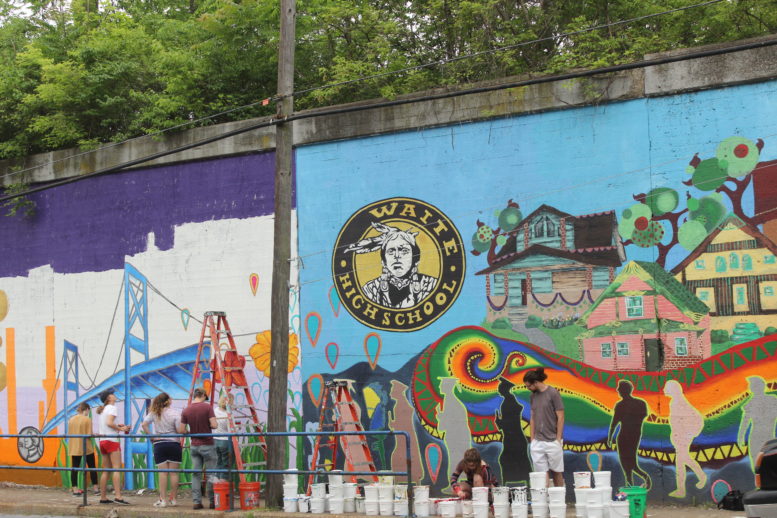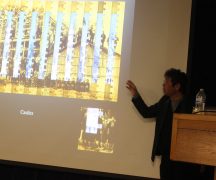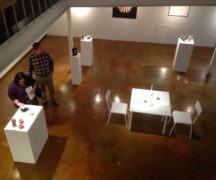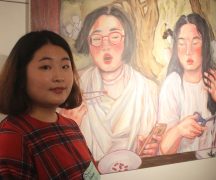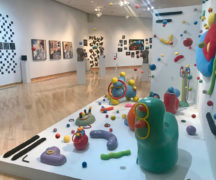By DAVID DUPONT
BG Independent News
Art students from Bowling Green State University have left their mark on the streets of Toledo’s Old South End and East Toledo.
Each summer since 2010, groups of students, under the direction of instructor Gordon Ricketts, have made their way to these neighborhoods to paint murals that bring a burst of color and inspiration to the residents.
This year, they’re at it again working on both sides of the river. In East Toledo, on East Broadway they contributing to a corridor of color started by previous students, visiting artists, and community members.
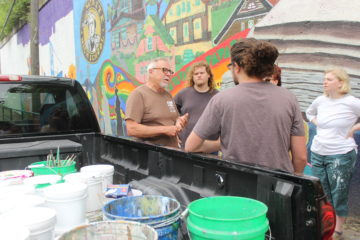
Gordon Ricketts, left, discusses the day’s work with student mural team.
Ricketts estimates the project has completed about two dozen murals in the southern end of the city. Driving down Broadway, headed west, you first encounter Martin Luther King Jr. on a wall, then nearby Cesar Chavez. Further down there’s the comic book character Green Lantern on the Green Lantern restaurant. Closer to the intersection of South Street, the murals multiply.
On a recent morning 15 students had gathered on East Broadway in East Toledo. Ladders up, and transforming a drab viaduct into a vivid celebration of the neighborhood. Trains rumble over the nearby overpass. Traffic whizzes by. Sometimes drivers honk approval and give a thumbs up.
Passers-by will express their appreciation and offer to pick up a brush. Ricketts points to a short wall where neighborhood children emulated the BGSU artwork.
“This is something that’s visual evidence that positive things are going on in their community,” Ricketts said.
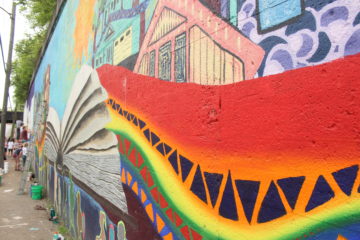 “These images are respected,” he said noting those done in previous years have not been tagged with graffiti. “They don’t mess with us.”
“These images are respected,” he said noting those done in previous years have not been tagged with graffiti. “They don’t mess with us.”
The first mural project was painted in summer of 2010. Ricketts was working with the Sofia Quintero Art and Cultural Center in the South End when discussions about murals began.
Ricketts worked with the BGSU School of Art to bring in Mario Torero, an artist he knew from San Diego. Torero has been creating murals since 1974 in Chicano Park.
The Toledo neighborhood “almost mirrors what’s going on in San Diego,” Ricketts said. “You end up with a neighborhood that’s split in two by a highway and marginalized. You have people trying to do good things for the neighborhood, to revitalize it.”
He, Torero, and Charles Kanwischer from the School of Art met with business proprietors, and attended Spanish-language mass to meet the priest and parishioners.
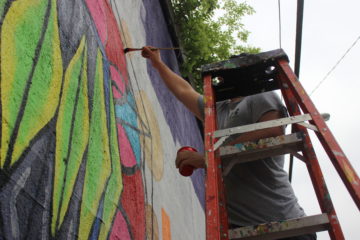 “We tried to integrate ourselves and make the mural about the neighborhood and what they’re interested in,” Ricketts said. “That’s an important part of the process.”
“We tried to integrate ourselves and make the mural about the neighborhood and what they’re interested in,” Ricketts said. “That’s an important part of the process.”
These cross-cultural conversations are an important part of what the students learn from the class.
The students who participated that first year were all volunteers.
The project went so well. The school brought Torero back four more years and created a summer course so students can earn credit. Another neighborhood group of young people spun off from the project and did their own murals.
Mary Wilson, an East Toledo native and activist liked what she saw across the Maumee, and approached Ricketts about going work in her Ironwood neighborhood. Wilson stops by to check on the progress of the murals, Ricketts said.
“She is always very nice to us,” said Anthony Kappler, one of the BGSU team. “She made us feel like we were part of the neighborhood.
The stretch of East Broadway is significant because it’s the route children travel to Oakdale Elementary and Waite High School.
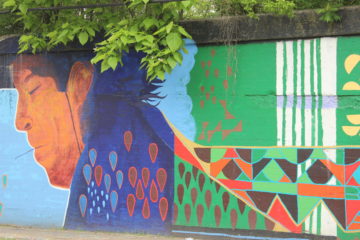
Yusuf Lateef’s dreamer.
The theme of this year’s project is youth and education with silhouettes of children walking to school a prominent feature. It also grows from a mural done last year by BGSU graduate Yusef Lateef. That depicts a dreamer, who has geometric fantasies flowing from his head. Now Lateef’s dreamer will look toward children heading off to school to make those dreams a reality.
For the BGSU students the work itself is an education.
Kappler took the mural class last summer. This summer, Ricketts hired him to document the process as part of a planned book.
“I think it challenged us as students,” he said. “As artists, most of the time we work by ourselves.” On the murals they work as part of a team.
For Erick Collier, who normally works in drawing and print, the large scale of the mural is appealing. “I like the power that the scale has.”
Collier also enjoys the physicality of the work, the necessity to move around and climb.
Cara Crocker, who grew up down the road in Rossford, said she was interested in the concept of public art. The murals” add vibrancy” to the neighborhood.
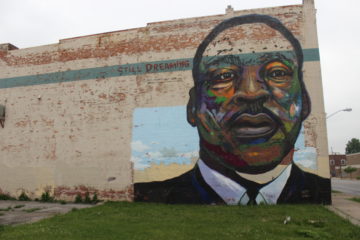
“Still dreaming” by Mario Torero
As with the early project, Ricketts made a point of connecting with community leaders. “We started with East Toledo Family Center and Ironwood Community group, and met with local principals to talk about what we were doing and our idea for themes,” Ricketts said. “We didn’t have a drawing, but they trusted us. Every year we come up with a new theme. This one had to do with childhood, education and neighborhood.”
The mural “celebrates East Toledo” with the silhouette of the refinery as well as depictions of community gardens.
A letter he received from a student in South Toledo brought home the impact the murals can have. The letter writer said the murals gave her a reason to be proud to be a Latina and proud of her community. He passed the letter on the director of the School of Art. The young woman is now a student at BGSU.
The project receives funding from a variety of sources on and off campus. That includes money from Ethnic Cultural Arts Program, School of Art, labor unions, the Quintero Center, and the Arts Council of Greater Toledo.
Ricketts estimates the murals cost about $5,000 a year. That includes an honorarium for a visiting artist – this year it is Mexican artist David Cuatlacuatl who is working at the intersection of Broadway and Maumee.
The paint is the biggest expense. It comes from a company in Los Angeles. One gallon of cobalt blue costs $165, Ricketts said. “It’s designed for murals. It lasts a long time. We hope for 20 years of vibrant color.”

